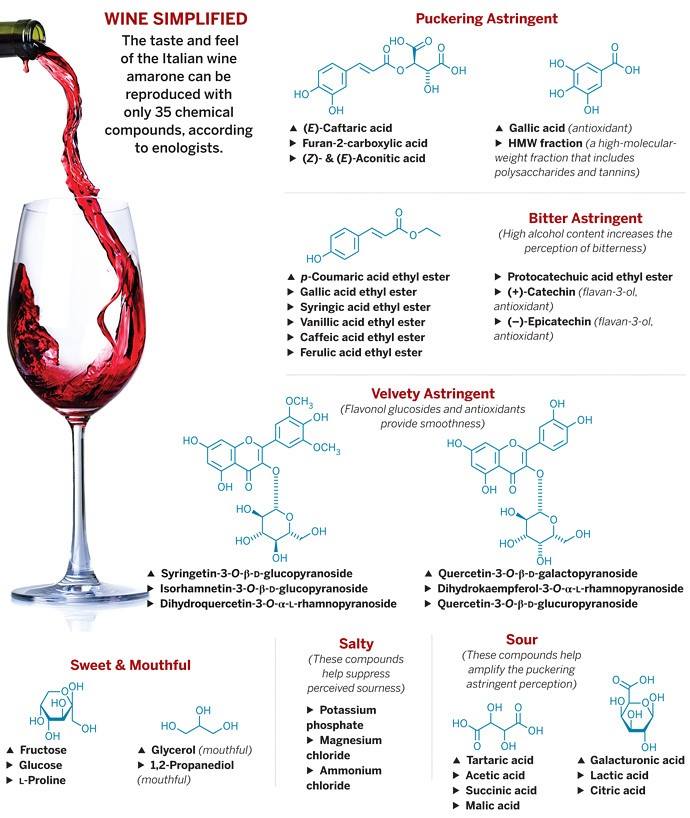와인 풍미요인 : 맛
식품의 역할 ≫ 기호성 ≫ 관능검사
관능(Wine 풍미) 영향요소
와인 풍미요인
- 맛성분
- 색과 식욕
c. Physicochemical Variation. We know that wine balance can be viewed as the reciprocal-type relationship indicated below. An increase in the perception of components on the left side decreases the perception of components on the right.
Sweet/Body ↔ Acid + Phenols (tannin intensity, astringency, dry tannins and bitterness)
Palate balance is impacted by a number of features, including temperature:
• Cooling reduces sweetness of sugars
• Cooling reduces bitterness of alkaloids
• Cooling increases the sense of acidity
• Cooling increases bitterness and astringency of tannins
Wineries generally serve all their whites at one temperature, and all their reds at another. Based on the palate balance relationship, this may not be optimal.
Sugars. Sugar concentrations above 0.2% are generally required to exhibit perceptible sweetness. When sweetness is detected in dry wines, it is usually due to the presence of a noticeable fruity fragrance. Association between fruity odors and sweetness has trained us to instinctively affiliate the presence of fruity odors with sweetness, even in its absence (Prescott, 2004).
Sugars begin to have a pronounced influence on sweetness and affect the perception of body at concentrations at or above 0.5%. The influence of aromatics on the perception of the sweetness of sugar can be very important. Thus, the fragrance of a wine may not only evoke the perception of sweetness, but also increase the perceived intensity of sweetness. We discussed this in relationship to rosé wine production.
Body. Despite the importance of body to the overall quality of wines, its precise origin remains unclear. Gawel et al. (2007) found a correlation between higher ratings for flavor and/or perceived viscosity with body. In sweet wines, body is often viewed as being roughly correlated with sugar content. In dry wines, it has often been associated with alcohol content.
There is evidence that the macromolecular content of wines (yeast proteins and polysaccharides) may play a role in the overall perception of body (Vidal et al., 2004a, b). Features such as a wine's fragrance can influence the perception of body and, conversely, increasing the sugar content can increase the perception of fragrance.
Polysaccharides. Polysaccharides, either grape- or yeast-derived, play a role in reducing acidity and astringency. They add to the perception of sweetness/body and
thus lower the perception on the other side of the palate balance relationship. This
influence can be significant, and is the basis for the interest in yeast fining and some
commercial addition products.
Alcohol. Ethanol possesses a sweet aspect. The acidity of wine diminishes as the
alcohol increases. Ethanol slightly enhances the sweetness of sugars, while reducing
the perception of acidity. At high concentrations (above 14%), alcohol increasingly
generates a burning sensation and may contribute to the feeling of weight or body,
especially in dry wines.
Acids. The effect of acidity in diminishing perceived sweetness appears less than that
of sugar in suppressing the perception of acidity (Ross and Weller, 2008). Of the
common acids found in wine, malic acid is the most sour tasting, whereas lactic acid is
generally considered the least sour.
The perceived intensity of a mixture generally reflects the intensity of the dominant
component, not a summation of their individual effects (McBride and Finlay, 1990).
pH also impacts taste perception, both directly by influencing the ionization of salts and
acids, and indirectly affecting the shape and biological activity of proteins. Structural
modification of receptor proteins on gustatory neurons could significantly affect taste
responsiveness.
The use of oral hygiene products, which can impact taste buds, make most wines taste
much more of acidity. The so-called Orange Juice Effect is the result of sodium lauryl
sulfate (or sodium dodecyl sulfate, two names for a common toothpaste ingredient) that
can react with taste buds (DeSimone et al., 1980). This is a primary reason why sensory
evaluations are generally not conducted too early in the morning.
Saltiness. The salt of some cheeses can suppress the bitterness of red wines. These
influences may or may not affect response time, duration, and maximum perceived
intensity.
Taste- and mouthfeel-components can affect taste:
• Ethanol enhances the perception of sugar-induced sweetness.
• Ethanol suppresses the astringency of tannins.
• Ethanol enhances flavonoid-induced bitterness (Noble, 1994) when the alcohol level is relatively high.
• Acids increase the perception of bitterness and astringency.
Mouthfeel. Mouthfeel is a generalized term used to describe the multiple sensations of
the following:
• astringency
• touch
• viscosity/body
• burning
• temperature
• prickling from carbon dioxide
• pain
